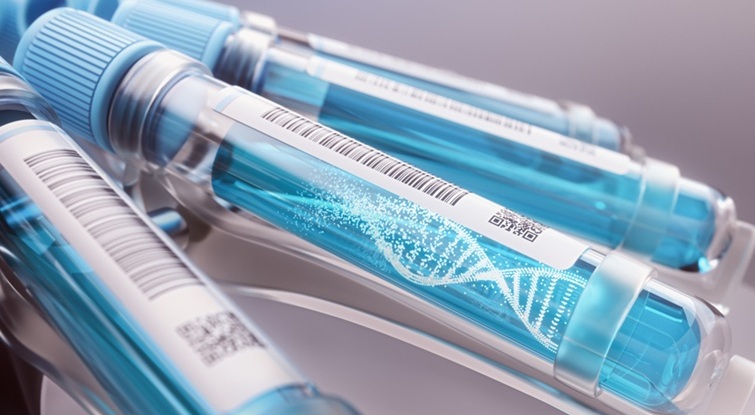Blood-Based Markers Tied to Brain Cell and Memory Loss
|
By LabMedica International staff writers Posted on 27 Apr 2021 |

Image: The Simoa HD-1 Analyzer (Photo courtesy of Quanterix)
Previous studies have linked elevated levels of plasma total tau and neurofilament light chain (NfL) with worse cognition and neuroimaging measures of cortical thickness, cortical atrophy, white matter hyperintensity, or white matter integrity.
Neurodegeneration, or brain cell loss, is characteristic of many disorders including Alzheimer's disease, vascular dementia, and Lewy body dementia. Causes and location of neurodegeneration in the brain vary with disease. In Alzheimer's disease, amyloid plaques and neurofibrillary tangles contribute to neurodegeneration and there tends to initially be more brain cell loss in the temporal lobe. In vascular-related cognitive impairment, infarct, white matter hyperintensities, and microbleeds can contribute to cognitive changes.
Neurologists at the Mayo Clinic (Rochester, MN) and their colleagues included 995 participants without dementia who were enrolled in the Mayo Clinic Study on Aging. All had concurrent plasma NfL and Total-tau, cognitive status, and neuroimaging data. Follow-up was repeated approximately every 15 months for a median of 6.2 years. Plasma NfL and T-tau were measured on the Simoa HD-1 Platform (Quanterix, Billerica, MA, USA).
The scientists reported that baseline plasma NfL, compared to T-tau, was more strongly associated with cognitive and neuroimaging outcomes in all analyses. The combination of having both elevated NfL and T-tau at baseline, however, was more strongly associated at cross-section with worse global cognition and memory and with neuroimaging measures including temporal cortex thickness and increased number of infarcts. Longitudinally, T-tau did not add to the prognostic value of NfL. Analyses using Alzheimer's Disease Neuroimaging Initiative (ADNI) had similar result.
Michelle M. Mielke, PhD, a Professor and a senior author of the study, said, “For prognosis purposes, neurofilament light better predicted the rate of neurodegeneration and cognitive decline, regardless of what the cause of neurodegeneration might be. NfL also may help determine how fast someone declines and how effective future therapies might be in slowing this decline.”
The authors concluded that overall, plasma NfL had better utility as a prognostic marker of cognitive decline and neuroimaging changes. Plasma T-tau adds cross-sectional value to NfL in specific contexts. The study was presented on April 18, 2021 at the American Academy of Neurology annual meeting.
Related Links:
Mayo Clinic
Quanterix
Neurodegeneration, or brain cell loss, is characteristic of many disorders including Alzheimer's disease, vascular dementia, and Lewy body dementia. Causes and location of neurodegeneration in the brain vary with disease. In Alzheimer's disease, amyloid plaques and neurofibrillary tangles contribute to neurodegeneration and there tends to initially be more brain cell loss in the temporal lobe. In vascular-related cognitive impairment, infarct, white matter hyperintensities, and microbleeds can contribute to cognitive changes.
Neurologists at the Mayo Clinic (Rochester, MN) and their colleagues included 995 participants without dementia who were enrolled in the Mayo Clinic Study on Aging. All had concurrent plasma NfL and Total-tau, cognitive status, and neuroimaging data. Follow-up was repeated approximately every 15 months for a median of 6.2 years. Plasma NfL and T-tau were measured on the Simoa HD-1 Platform (Quanterix, Billerica, MA, USA).
The scientists reported that baseline plasma NfL, compared to T-tau, was more strongly associated with cognitive and neuroimaging outcomes in all analyses. The combination of having both elevated NfL and T-tau at baseline, however, was more strongly associated at cross-section with worse global cognition and memory and with neuroimaging measures including temporal cortex thickness and increased number of infarcts. Longitudinally, T-tau did not add to the prognostic value of NfL. Analyses using Alzheimer's Disease Neuroimaging Initiative (ADNI) had similar result.
Michelle M. Mielke, PhD, a Professor and a senior author of the study, said, “For prognosis purposes, neurofilament light better predicted the rate of neurodegeneration and cognitive decline, regardless of what the cause of neurodegeneration might be. NfL also may help determine how fast someone declines and how effective future therapies might be in slowing this decline.”
The authors concluded that overall, plasma NfL had better utility as a prognostic marker of cognitive decline and neuroimaging changes. Plasma T-tau adds cross-sectional value to NfL in specific contexts. The study was presented on April 18, 2021 at the American Academy of Neurology annual meeting.
Related Links:
Mayo Clinic
Quanterix
Latest Clinical Chem. News
- Compact Raman Imaging System Detects Subtle Tumor Signals
- Noninvasive Blood-Glucose Monitoring to Replace Finger Pricks for Diabetics
- POC Breath Diagnostic System to Detect Pneumonia-Causing Pathogens
- Online Tool Detects Drug Exposure Directly from Patient Samples
- Chemical Imaging Probe Could Track and Treat Prostate Cancer
- Mismatch Between Two Common Kidney Function Tests Indicates Serious Health Problems
- VOCs Show Promise for Early Multi-Cancer Detection
- Portable Raman Spectroscopy Offers Cost-Effective Kidney Disease Diagnosis at POC
- Gold Nanoparticles to Improve Accuracy of Ovarian Cancer Diagnosis
- Simultaneous Cell Isolation Technology Improves Cancer Diagnostic Accuracy
- Simple Non-Invasive Hair-Based Test Could Speed ALS Diagnosis
- Paper Strip Saliva Test Detects Elevated Uric Acid Levels Without Blood Draws
- Prostate Cancer Markers Based on Chemical Make-Up of Calcifications to Speed Up Detection
- Breath Test Could Help Detect Blood Cancers
- ML-Powered Gas Sensors to Detect Pathogens and AMR at POC
- Saliva-Based Cancer Detection Technology Eliminates Need for Complex Sample Preparation
Channels
Molecular Diagnostics
view channel
Urine Test Could Reveal Real Age and Life Span
Chronological age does not always reflect how quickly the body is aging, as biological age is shaped by genetics, stress, sleep, nutrition, and lifestyle factors such as smoking. A higher biological age... Read more
Genomic Test Identifies African Americans at Risk for Early Prostate Cancer Recurrence
Prostate cancer is one of the most commonly diagnosed cancers in men and a leading cause of cancer-related death, particularly in the United States. African American men face a disproportionately higher... Read moreHematology
view channel
MRD Tests Could Predict Survival in Leukemia Patients
Acute myeloid leukemia is an aggressive blood cancer that disrupts normal blood cell production and often relapses even after intensive treatment. Clinicians currently lack early, reliable markers to predict... Read more
Platelet Activity Blood Test in Middle Age Could Identify Early Alzheimer’s Risk
Early detection of Alzheimer’s disease remains one of the biggest unmet needs in neurology, particularly because the biological changes underlying the disorder begin decades before memory symptoms appear.... Read more
Microvesicles Measurement Could Detect Vascular Injury in Sickle Cell Disease Patients
Assessing disease severity in sickle cell disease (SCD) remains challenging, especially when trying to predict hemolysis, vascular injury, and risk of complications such as vaso-occlusive crises.... Read more
ADLM’s New Coagulation Testing Guidance to Improve Care for Patients on Blood Thinners
Direct oral anticoagulants (DOACs) are one of the most common types of blood thinners. Patients take them to prevent a host of complications that could arise from blood clotting, including stroke, deep... Read moreImmunology
view channel
Ultrasensitive Liquid Biopsy Demonstrates Efficacy in Predicting Immunotherapy Response
Immunotherapy has transformed cancer treatment, but only a small proportion of patients experience lasting benefit, with response rates often remaining between 10% and 20%. Clinicians currently lack reliable... Read more
Blood Test Could Identify Colon Cancer Patients to Benefit from NSAIDs
Colon cancer remains a major cause of cancer-related illness, with many patients facing relapse even after surgery and chemotherapy. Up to 40% of people with stage III disease experience recurrence, highlighting... Read moreMicrobiology
view channel
New UTI Diagnosis Method Delivers Antibiotic Resistance Results 24 Hours Earlier
Urinary tract infections affect around 152 million people every year, making them one of the most common bacterial infections worldwide. In routine medical practice, diagnosis often relies on rapid urine... Read more
Breakthroughs in Microbial Analysis to Enhance Disease Prediction
Microorganisms shape human health, ecosystems, and the planet’s climate, yet identifying them and understanding how they are related remains a major scientific challenge. Even with modern DNA sequencing,... Read morePathology
view channel
Genetics and AI Improve Diagnosis of Aortic Stenosis
Aortic stenosis is a progressive narrowing of the aortic valve that restricts blood flow from the heart and can be fatal if left untreated. There are currently no medical therapies that can prevent or... Read more
AI Tool Simultaneously Identifies Genetic Mutations and Disease Type
Interpreting genetic test results remains a major challenge in modern medicine, particularly for rare and complex diseases. While existing tools can indicate whether a genetic mutation is harmful, they... Read more
Rapid Low-Cost Tests Can Prevent Child Deaths from Contaminated Medicinal Syrups
Medicinal syrups contaminated with toxic chemicals have caused the deaths of hundreds of children worldwide, exposing a critical gap in how these products are tested before reaching patients.... Read more
Tumor Signals in Saliva and Blood Enable Non-Invasive Monitoring of Head and Neck Cancer
Head and neck cancers are among the most aggressive malignancies worldwide, with nearly 900,000 new cases diagnosed each year. Monitoring these cancers for recurrence or relapse typically relies on tissue... Read moreTechnology
view channel
Pioneering Blood Test Detects Lung Cancer Using Infrared Imaging
Detecting cancer early and tracking how it responds to treatment remains a major challenge, particularly when cancer cells are present in extremely low numbers in the bloodstream. Circulating tumor cells... Read more
AI Predicts Colorectal Cancer Survival Using Clinical and Molecular Features
Colorectal cancer is one of the most common and deadly cancers worldwide, and accurately predicting patient survival remains a major clinical challenge. Traditional prognostic tools often rely on either... Read moreIndustry
view channel
BD and Penn Institute Collaborate to Advance Immunotherapy through Flow Cytometry
BD (Becton, Dickinson and Company, Franklin Lakes, NJ, USA) has entered into a strategic collaboration with the Institute for Immunology and Immune Health (I3H, Philadelphia, PA, USA) at the University... Read more



















